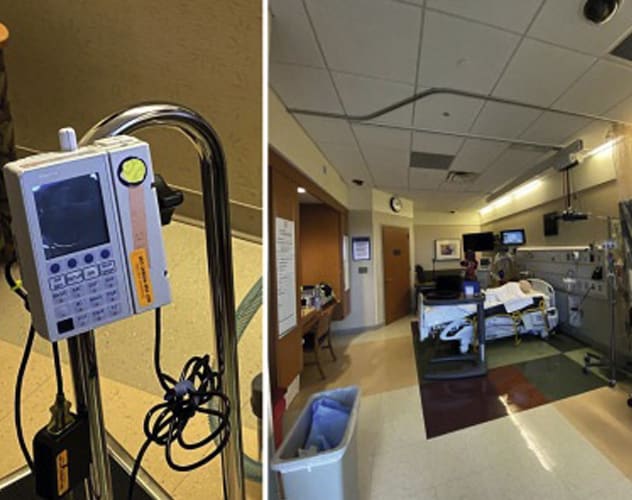March 13, 2021
Mayo Clinic has demonstrated the feasibility of using a robotic system to perform simple tasks in a coronavirus disease 2019 (COVID-19) patient room. Mayo's experiment, which used a manikin in a simulated intensive care unit (ICU) room, shows the potential of robotics to reduce the use of personal protective equipment (PPE) and the exposure of health care workers to COVID-19.
"COVID-19 forced us to really look at how robotics might be integrated into patient care," says William D. Freeman, M.D., a neurocritical care specialist at Mayo Clinic in Jacksonville, Florida. "Compared to other industries, health care needs to catch up with automation."
The experiment, described in the February 2021 issue of Mayo Clinic Proceedings: Innovations, Quality & Outcomes, demonstrated the ability of a robot to successfully:
- Push a button on an intravenous pole
- Adjust a ventilator knob
- Push an ICU monitor button to silence an alarm for false alerts
- Adjust an oxygen flow rate knob
- Push a nurse call button to "off"
"Having a robotic system to perform simple tasks is a huge asset to bedside nursing," says Suzanne M. Brown, R.N., a neurology nurse at the Jacksonville campus of Mayo Clinic. "The robotic system helps reduce the number of times a nurse has to enter a COVID-19 room and — just as importantly — helps patients to feel their needs are being attended to in a timely manner, without waiting for someone to don PPE."
Mayo Clinic is committed to embracing technologies that demonstrably benefit patients. Well before the COVID-19 outbreak, Mayo pioneered the use of robot-assisted telemedicine, particularly for the treatment of stroke.
In the pandemic's early days, Leslie V. Simon, D.O., the Emergency Medicine chair at Mayo's campus in Jacksonville, arranged with Dr. Freeman to borrow the robot used in the ICU for remote stroke evaluations. "We put the robot in our triage room," Dr. Simon says.
Patients with COVID-19 who didn't need any procedures or physical interventions were evaluated remotely by physicians with the help of nurses wearing PPE who were with the patients in the triage room. The study assessing the robot's ability to perform tasks arose from that experience.
"We have talked a lot about what forms of virtual medicine we might practice in the emergency department by 2030. It's amazing how necessity can speed things up," Dr. Simon says. "We went from 2020 to 2030 in 12 hours."
Further studies are needed to determine if a robot might be able to perform more-complicated tasks. "We want to think big about what the hospital of the future might look like and how robots could help patients there or maybe even in a home setting," Dr. Freeman says. "That means envisioning what works from a functional, ergonomic and aesthetic standpoint."
Saving 2 rounds of PPE
Up to 10% of patients with COVID-19 require ICU care. Mayo Clinic launched the robotics experiment early in the pandemic, when the need to conserve PPE and to safeguard health care workers became apparent.
The researchers first surveyed physicians, nurses, therapists and other allied health workers to determine what tasks they might like to have performed robotically. Jorge M. Mallea, M.D., a pulmonary critical care physician at Mayo's campus in Florida, noted that the oxygen saturation of a patient receiving supplemental oxygen via nasal cannula often decreases when the person walks to the bathroom or transfers to a chair.
"The patient feels short of breath, an alarm sounds in the room, and a nurse must put on PPE and go inside to adjust the oxygen level," Dr. Mallea says. "When the patient returns to bed, the nurse must go in to readjust the oxygen level. We could prevent two rounds of PPE use and of health care workers' exposure to the virus if a robot performed a task as simple as turning a knob."
Automating simple tasks

Automating simple tasks
Photograph shows the robotic system in a simulated intensive care unit room. Image reprinted with permission from Mayo Clinic Proceedings: Innovations, Quality & Outcomes.
After identifying several basic care tasks, the researchers programmed a robotic system to perform them in the simulated ICU room. The robot's ability to complete the tasks repeatedly and reliably, without damaging the manikin or ICU room equipment, was evaluated.
No safety concerns were observed, although some repositioning of the robot was necessary. For example, the robot's base was moved farther from the manikin after an initial attempt to silence the bedside call button showed the robotic elbow coming closer than most patients might feel comfortable. "It is important to pay attention to those kinds of details so that automation is used in a way that helps patients," Dr. Freeman says.
Using the survey of COVID-19 care providers at Mayo, the researchers identified additional tasks that might eventually be performed robotically. These include repositioning or boosting a patient in bed, helping to take a sequential compression device on or off, and performing range of motion activities with a patient.
"With a robotic presence at the bedside, nurses will be able to focus on more-critical aspects of patient care — including hemodynamics, focused assessments, timely documentation and communication, and collaboration with the health care team," Brown says.
"The epicenter of our mission is the patient," Dr. Freeman adds. "We want every patient in a Mayo Clinic hospital to be at the cutting edge of technology, with the most sophisticated yet elegant setting. Freeing health care workers from repetitive tasks can allow more time for human connection, which is the essence of the patient relationship."
For more information
Freeman WD, et al. Robotics in simulated COVID-19 patient room for health care worker effector tasks: Preliminary, feasibility experiments. Mayo Clinic Proceedings: Innovations, Quality & Outcomes. 2021;5:161.